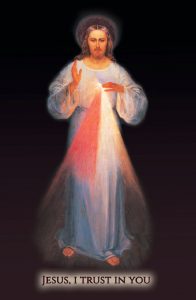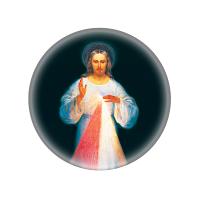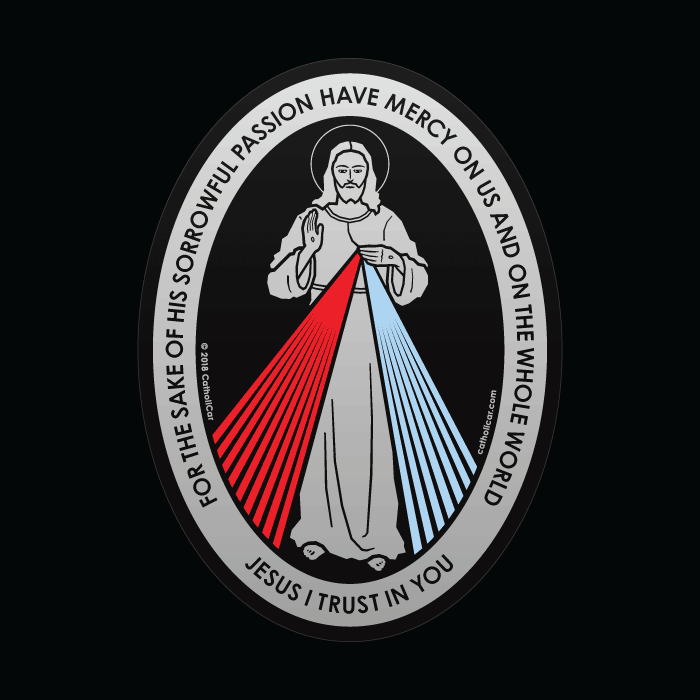The Divine Mercy Image, a central component of the Divine Mercy devotion, is a painting that portrays Jesus Christ as a symbol of divine love and forgiveness. As one of the most recognizable and revered images in modern Catholicism, the painting’s origin, meaning, and history hold deep spiritual significance for believers.
This article delves into the story behind the Divine Mercy Image and its role in the devotion.
 The Origin of the Divine Mercy Image
The Origin of the Divine Mercy Image
The Divine Mercy Image traces its origin to the visions of St. Faustina Kowalska, a Polish nun who received a series of messages from Jesus Christ in the 1930s. In one of these visions, Jesus appeared to Sister Faustina as the Divine Mercy, instructing her to have an image painted according to the vision she received.
Sister Faustina described the image to her spiritual director, Father Michael Sopocko, who commissioned artist Eugene Kazimierowski to create the painting. Completed in 1934, the original Divine Mercy Image is now housed at the Divine Mercy Sanctuary in Vilnius, Lithuania.
The Meaning and Symbolism of the Divine Mercy Image
The Divine Mercy Image depicts Jesus with His right hand raised in blessing and His left hand touching His chest, where two rays emanate – one red and one white. The red ray symbolizes the Blood of Jesus, representing His sacrificial love and the Eucharist, while the white ray represents the water, signifying the purifying power of Baptism and the gift of the Holy Spirit.
At the bottom of the image, the inscription “Jesus, I trust in You” serves as a reminder of the central message of the Divine Mercy devotion: to trust in the infinite mercy and love of Jesus Christ.
 The painting’s composition, with Jesus stepping forward, conveys the idea that Christ is actively offering His mercy and forgiveness to all who seek it. The image serves as a visual representation of the Divine Mercy devotion’s core tenets – trust, forgiveness, and the transformative power of God’s love.
The painting’s composition, with Jesus stepping forward, conveys the idea that Christ is actively offering His mercy and forgiveness to all who seek it. The image serves as a visual representation of the Divine Mercy devotion’s core tenets – trust, forgiveness, and the transformative power of God’s love.
The History of the Divine Mercy Image
Since its creation in 1934, the Divine Mercy Image has inspired countless reproductions, adaptations, and variations. The image has spread worldwide, becoming a central focus of prayer and veneration in churches, homes, and Divine Mercy shrines. In 1943, another version of the image was painted by Adolf Hyła and presented to the Congregation of the Sisters of Our Lady of Mercy in Krakow, Poland. This version, often referred to as the “Hyła Image,” has become one of the most widely recognized and reproduced renditions of the Divine Mercy Image.
Throughout its history, the Divine Mercy Image has been associated with numerous miracles, conversions, and instances of divine intervention. Many believers report experiencing a profound sense of peace, healing, and spiritual connection when praying before the image.
The Divine Mercy Image Today
Today, the Divine Mercy Image continues to hold a central place in the hearts and minds of millions of Catholics worldwide. The image is venerated on Divine Mercy Sunday, the first Sunday after Easter, and throughout the year in personal prayer and devotion. The Divine Mercy Image serves as a constant reminder of the love, compassion, and forgiveness that Jesus offers to all who turn to Him in trust.
The Divine Mercy Image, with its rich history and profound symbolism, remains a powerful representation of God’s love and mercy. For believers, the image is a visual testament to the transformative power of divine compassion and serves as a source of hope, solace, and inspiration in their spiritual journey.
Learn more about the global impact of the Divine Mercy devotion
Article: Miraculous Origins of Divine Mercy
Article: St. John Paul II and Divine Mercy
Article: Miracles of St. Faustina
Shop for Divine Mercy devotional items at CatholicShop.com
And much more!
SHOP NOW









